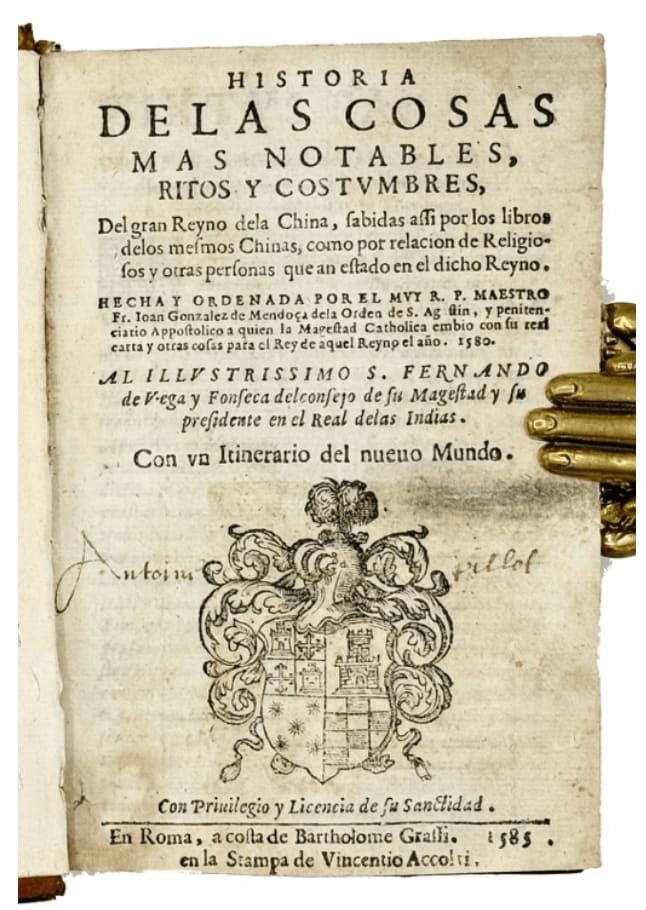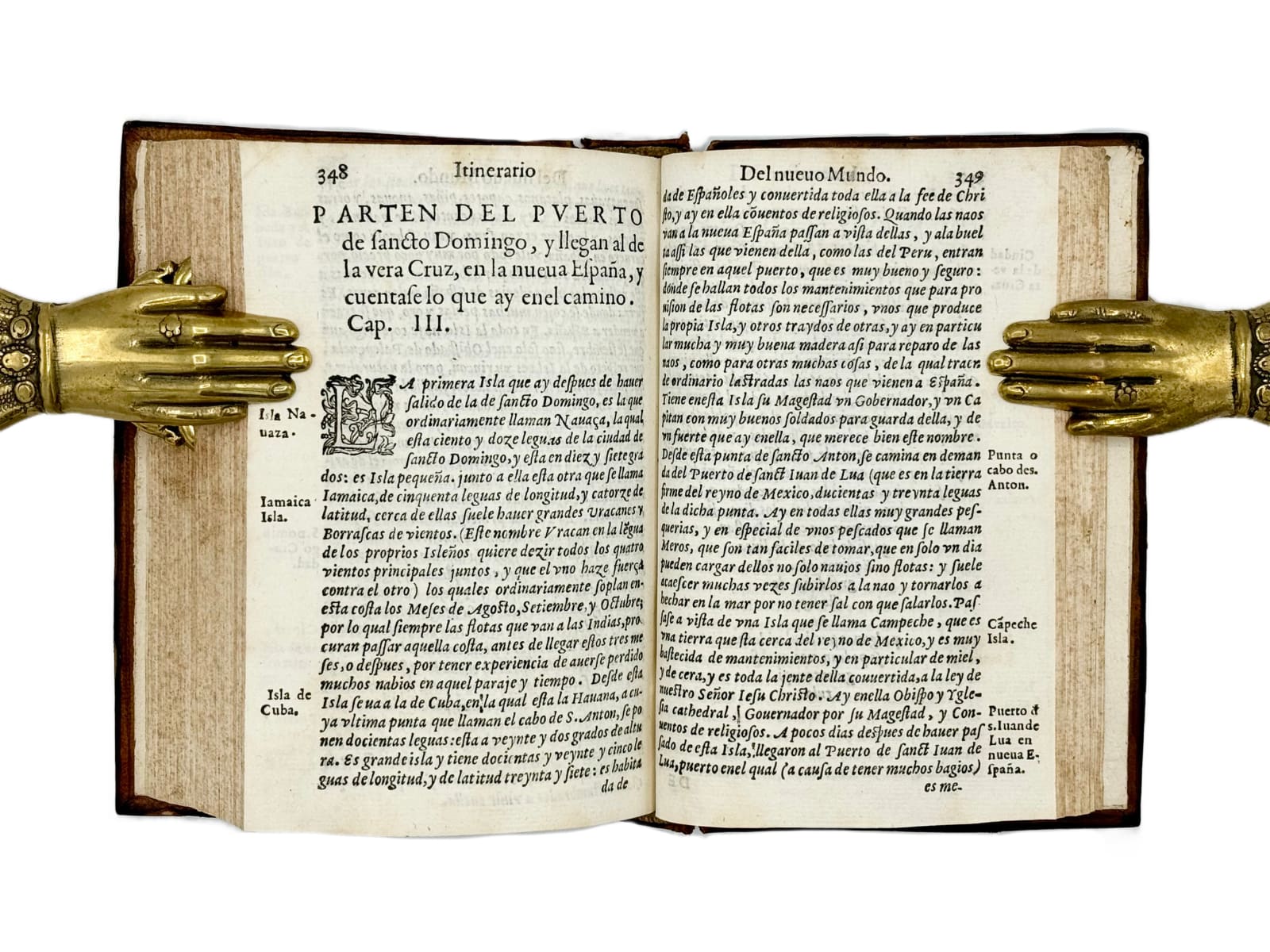








Gonzalez de Mendoza, Juan
First edition of the first major survey of China, and an early Americana, noted by Sabin as the “First European book in which Chinese characters occur” (Sabin); it was translated into Italian, French, Latin, German, and English by order of Richard Hakluyt by Robert Parke. It was a true 16th century best seller and the first serious work on China, influential for over a century. Finally, it also contains significant material on the Philippines.
Further images
-
(View a larger image of thumbnail 1
)

-
(View a larger image of thumbnail 2
)

-
(View a larger image of thumbnail 3
)

-
(View a larger image of thumbnail 4
)

-
(View a larger image of thumbnail 5
)

-
(View a larger image of thumbnail 6
)

-
(View a larger image of thumbnail 7
)

-
(View a larger image of thumbnail 8
)

-
(View a larger image of thumbnail 9
)

8vo, (152 x 98 mm). 15 ff., 440 pp. Seventeenth or eighteenth century calf, raised bands to spine, dark lettering piece, compartments richly gilt, split inner hinge, red-speckled edges slightly worn, some worming and wear to spine head. Title lightly browned, with a faint contemporary signature “Antoini Pillot(?)”and an erased signature at an early time, text somewhat trimmed, overall clean with only occasional foxing and light browning, dampstaining to pp. 289-337, 353-370, 391-420, else a very fine copy.
“… It is probably no exaggeration to say that Mendoza’s book had been read by the majority of well-educated Europeans at the beginning of the seventeenth-century. Its influence was naturally enormous” (Boxer, xvii).
“[T]he most comprehensive and popular book on Ming China to appear in Europe” (Lach).
It’s relevance for Americana is concentrated from page 341-440, beginning with the Ytinerario del Padre… Martin Ignacio… de la Provincia de S. Ioseph… y de la vuelta que dio por la India Oriental y otros Reynos, rodeando el Mundo. According to Sabin, it provides “curious details concerning the Canaries, St. Domingo, Jamaica, Cuba, Porto Rico, and especially Mexico. Ortelius, in his Atlas, declared that he had received more information concerning America from this Itinerary than from any other single book”. This edition contains Loyola’s account of Antonio de Espejo’s exploration of New Mexico, which was never published separately. The American part begins with the voyage undertaken by the Franciscan Martin Ignacio towards Santo Domingo and Mexico.
“The notes of Martin de Rada, or de Harrada, in the first expedition (along with Pedro Sarmiento) in 1575, and those of Gonzalez de Mendoza on his mission in 1578, enabled the latter to write the Historia. A third journey in 1581, by Martin Ignacio de Loyola, furnished the Itinerario, which includes Mexico and the Philippines. This Itinerario is very interesting. Fr. Ignacio on his Voyage to China went via the Canaries and St. Domingo, from there he passed to Vera Cruz, across Mexico, between Mexico and Acapulco, and re-embarked from this port for the Philippines and China. Although brief, the account of the Voyage is extremely interesting. He speaks of the discovery of New Mexico by Ant. d’Espejo. The itinerary gives curious details concerning the Canaries, St. Domingo, Jamaica, Cuba, Porto Rico, and especially Mexico”. (Maggs, 1926, 4048).
“According to Tavera (Biblioteca Filipina, no. 1199) the work is of the greatest importance as the first book printed in Europe to speak of the newly founded city of Manila. In part 2 (chapters 1 to 10) the author mentions the celebrated pirate Limahong, whose attacks threatened the new city until he was defeated. Chapters 7 and 8 of the Itinerario also describe the Philippines, giving many curious details about contemporary life in the islands.” (William Schab).
Even though Augustinian Father Gonzalez de Mendoza (1545 - 1618) never actually made it to China, a commission fell on him to write a history of what was known to Europeans on the Kingdom of China, which was to include details on the country’s language, politics, geography and population; that he did, compiling from available sources of information, such as missionaries and explorers’ accounts (namely that of Martin de Rada, from whose relation we obtain much of what we know of the earliest settlements in Manila). Martin de Rada joined Urdaneta in his expedition from Mexico to the Philippines, commanded by Miguel Lopez de Legazpi, from there, he travelled to China in 1575, where he wrote his observations on the Chinese people and their way of life; later on he would die at sea on his way back to Manila.
Cordier Sinica I: 8; Sabin 27775; Salva 3330 ('mui rara'); Palau, 105495; Löwendahl 13.
Join our mailing list
* denotes required fields
We will process the personal data you have supplied in accordance with our privacy policy (available on request). You can unsubscribe or change your preferences at any time by clicking the link in our emails.
